Spain Women will be participating in the Women’s football tournament of the 2024 Summer Olympics in Paris as current World Cup Champions, and therefore, the target will obviously be winning the gold medal.
Following numerous convincing performances on big occasions crowned by a World Cup success story, the time has come for Spain to battle for the Olympics and make their first-ever participation in this tournament a remarkable one.
This competition comes at the perfect time for Spain as they failed to qualify for it before.
Now, they enter as World Cup champions and UEFA Women’s Nations League champions.
In fact, Spain were capable of leading Group A4, which consisted of tough teams like Sweden, Italy and Switzerland.
Afterwards, they had to play the Netherlands in the semi-finals and beat them in order to get their ticket to the 2024 Summer Olympics, knowing that the top three teams of the UEFA Women’s Nations League are the ones who qualify for this Olympic tournament.
The idea is to build on this success and continue the successful journey of titles by performing well in Group C with Nigeria, Japan and Brazil and top this group to see what they can achieve when passing to the knockout stage.
Although this group might look “okay” for Spain, avoiding underestimation will be very important as all of these three teams can disturb Spain and eventually win points against them, especially if Spain falls into the trap of underestimation.
If things go well for Spain in this group stage, teams like the USWNT, Germany, France, and Canada will be able to knock Spain out of the tournament.
Therefore, Spain will have to prepare well for this competition as, unlike many other participating teams, they don’t have Olympic experience.
Also, paying extra attention to details and to opponents’ characteristics will be vital to surpassing the needed obstacles during the tournament, and that will mainly be Montserrat Tomé and her staff’s role.
This tactical analysis scout report will be presenting the predicted starting line-up, the team’s attacking and defensive tactics in addition to an analysis of the key players within the the Spanish team.
Predicted Starting XI
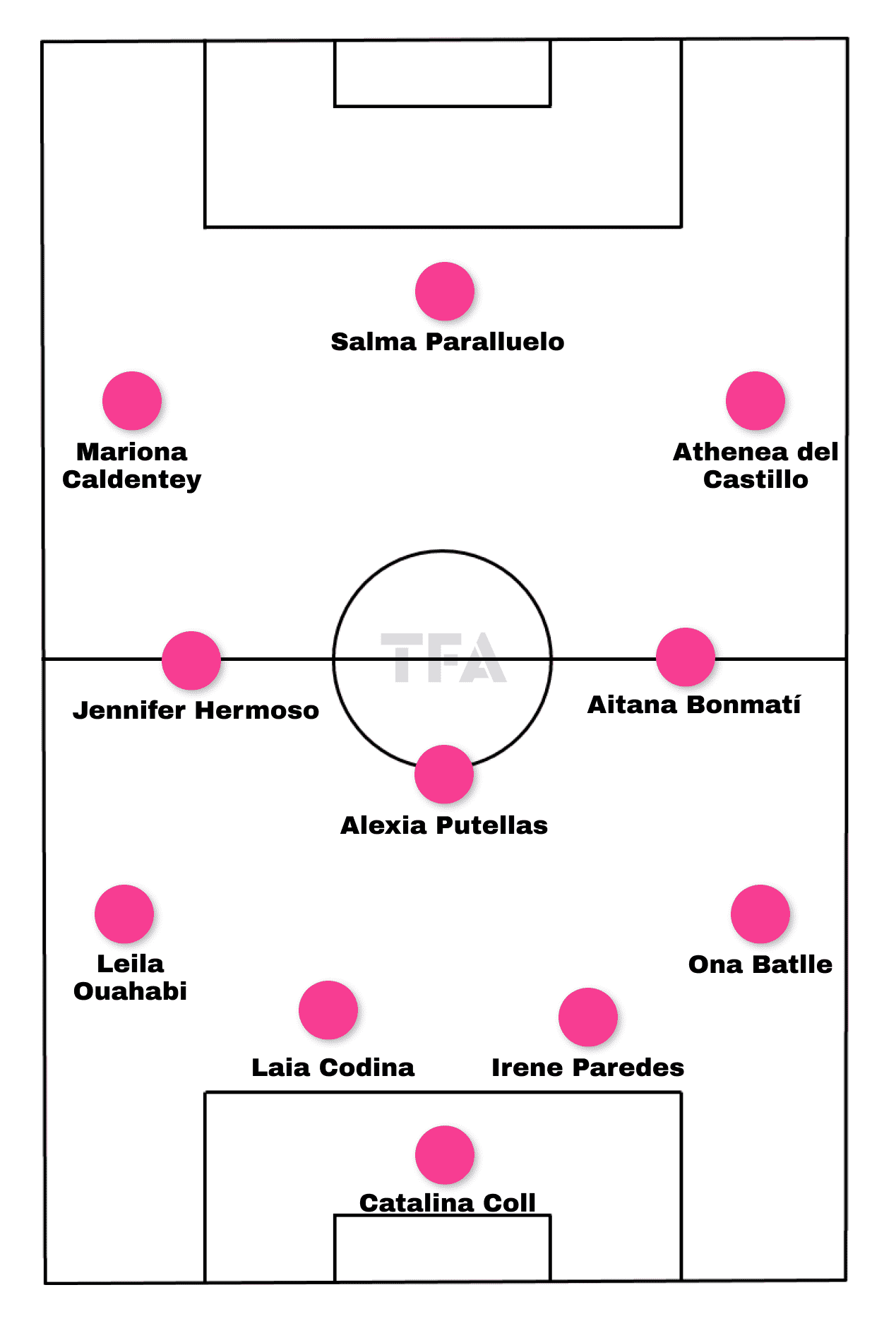
Montserrat Tomé will most probably be using the 4-3-3 formation during the Summer Olympics since it has been the formation that Spain used the most during the latest big tournaments.
Although there was a change of head coach in the meantime, it is important to note that Spain won the latest edition of the World Cup using the 4-3-3 formation under the management of Jorge Vilda.
It is also true that Tomé has been trying different formations during the recent period, such as the 4-1-4-1, the 3-5-2, and the 4-2-3-1.
Tomé will most probably opt for Cata Coll as a first-choice goalkeeper since she is the first-choice goalkeeper for both Spain and Barcelona Women and has an advantage over Real Madrid’s Misa Rodríguez.
Taking into account Olga Carmona’s injury, Tomé will have to use Manchester City’s Leila Ouahabi as a left-back, Laia Codina and Irene Paredes as centre-backs, and Ona Battle as a right-back if she recovers quickly from her injury.
In midfield, things are relatively simple for Tomé since the team has some of the best midfielders in the world at the moment.
She will most likely be using Alexia Putellas as a defensive midfielder and Aitana Bonmatí and Jennifer Hermoso as central midfielders, precisely like the team was playing during the World Cup.
That being said, a few alternations can happen during the tournament, as someone like Teresa Abelleira can replace Putellas effectively whenever needed.
The attacking three will most likely be Mariona Caldentey as a left winger, Athenea del Castillo on the right-wing and Salma Paralluelo as a striker.
Changes can also be made to this attacking three line-up as names like Esther González, Lucía García and Atlético Madrid‘s Eva Navarro can represent key second-half weapons for Tomé.
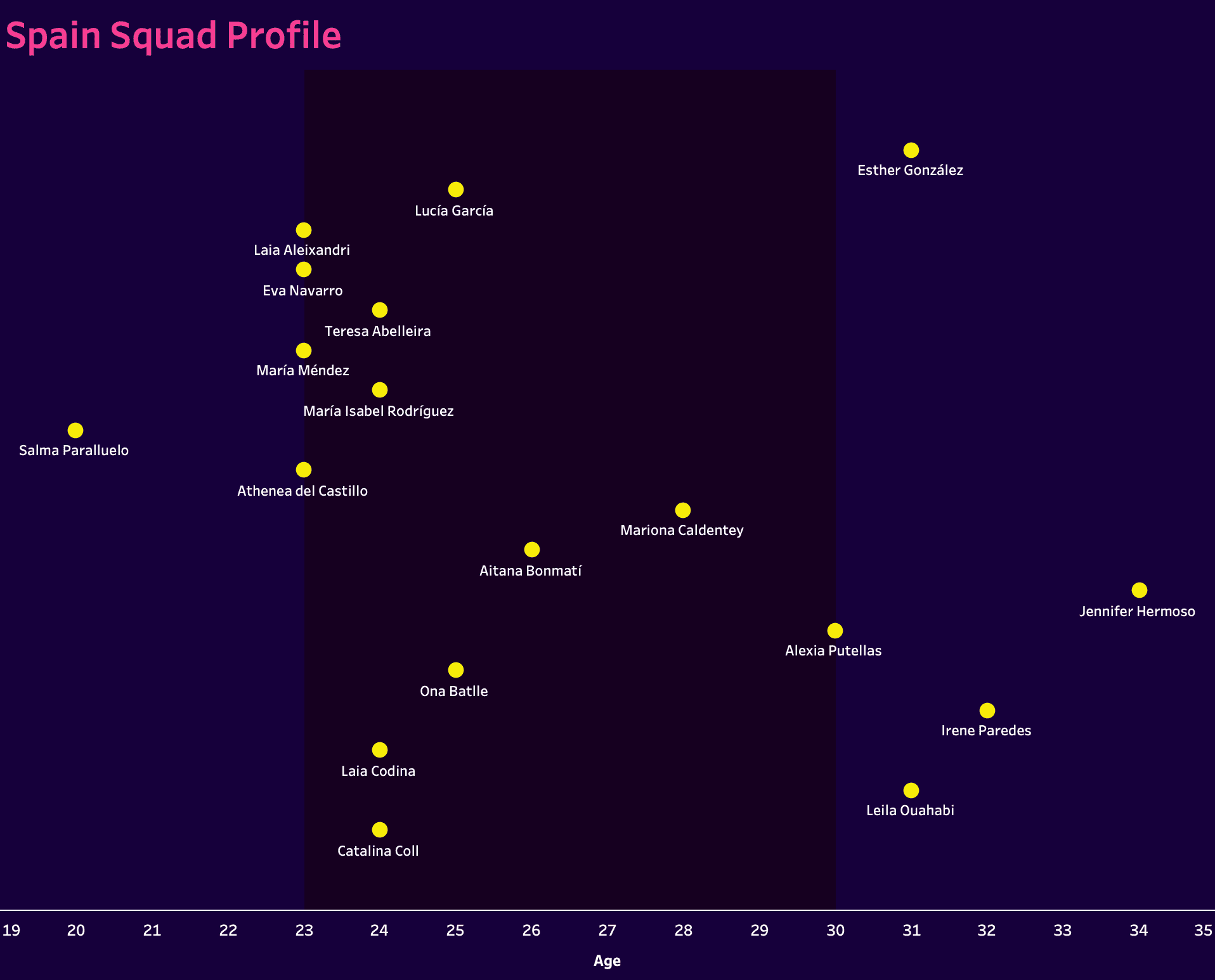
In terms of the players’ average age in this squad, we can argue that Spain’s team for the Summer Olympics looks rejuvenated with numerous players who are about to reach their peak years, such as Salma Paralluelo, del Castillo, María Méndez, Eva Navarro and Laia Aleixandri.
At the same time, the team does not lack experience, as names like Putallas, Ouahabi, Caldentey, and Aitana Bonmatí can help a lot in dealing with complex situations during games and in helping the younger players gain more confidence and play with more ease.
Even the players who are “past their peak years,” as the graphic shows, and who are mainly Irene Paredes and Jenni Hermoso, are still in very good physical shape.
They are capable of giving 150% and playing 90 minutes.
Therefore, age will not represent a problem for this Spanish team, especially if they get lucky enough and are not subject to injuries.
Attacking Phase
When it comes to Spain’s attacking phase, it should be said that Spain has one of the most dangerous attacks in this tournament and is capable of punishing any defence.
The reasons for this powerful attacking phase lie mainly in the team’s ability to attack with numerous quality players and in the midfielders’ world-class attacking and playmaking talents, which help them build up with high success rates and reach the final third quite easily.
The addition of Putellas, Bonmatí, and Hermoso should never be undermined or overlooked, as these players are central to most, if not all, of Spain’s attacks.
Whether with key passes, penetrations, or shots from distance, all three players proved on numerous occasions that they can be very dangerous as soon as they get close to the penalty box.
It is enough to mention that the team’s overall passing accuracy equals 86.7% to understand how effective these players can be in terms of playmaking and building-up from the back.
Moreover, with 79.2% of passes towards the final third accuracy rate, we can say that Spain does not have chance creation issues at all and are capable of staying for a long time in their opponent’s final third, which makes their probability of scoring goals higher.
The following example highlights the addition of Spain’s midfield players and their efficiency inside the box, as all of them tend to participate actively in attack and know exactly when and how to move without the ball to provide passing options and eventually finish actions, too.
This goal against Switzerland shows how Paralluelo and Putellas exchanged roles as Paralluelo penetrated with the ball toward the left side of the box, and Putellas came from behind and positioned herself in the centre of the box to be able to receive a pass from Paralluelo and finish the action inside the net.
These movements and automatic roles changes inside the final third make Spain’s attacking plans hard to predict.
They always tend to diversify their actions while focusing mainly on quick, short passes between the lines and moving intelligently without the ball.
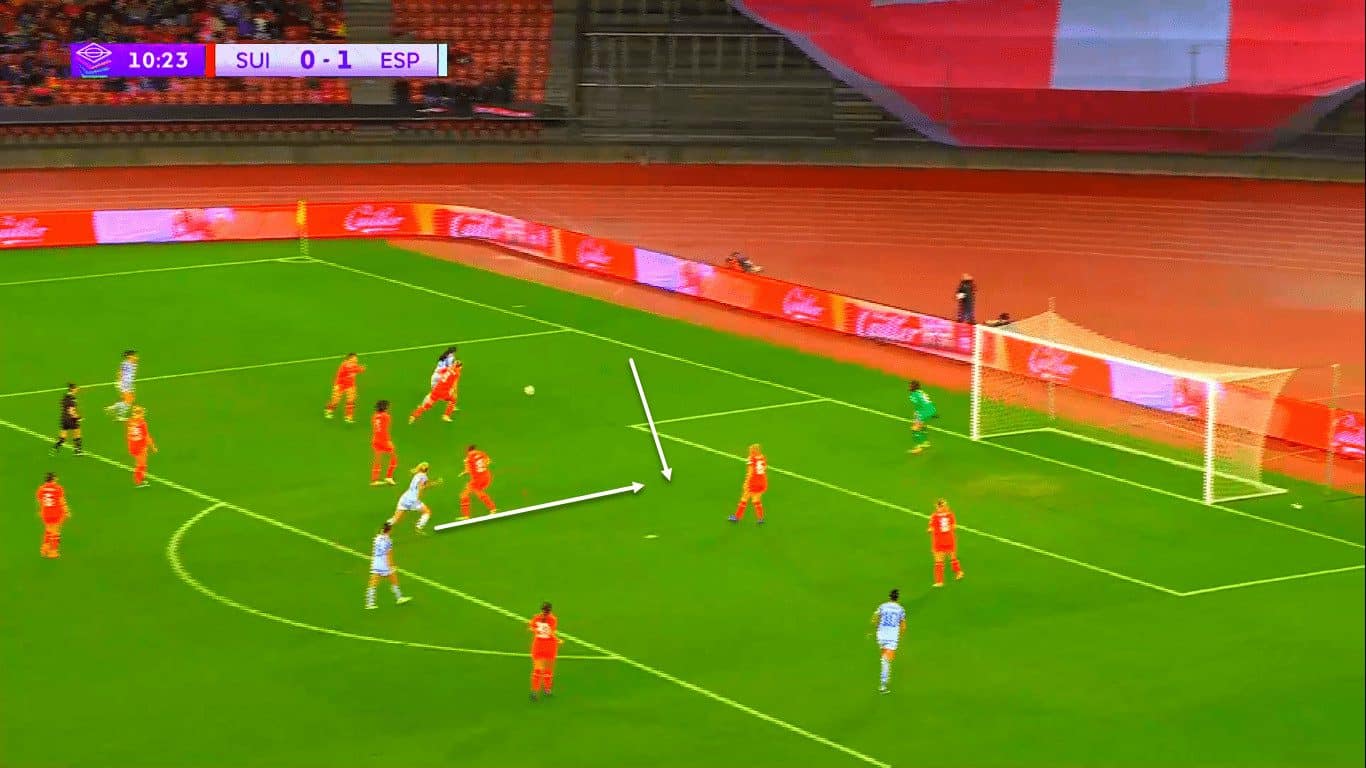
Finishing does not represent an issue for Spain either, as they actually have some very talented players up front.
Caldentey who has remarkable pace, dribbling skills and shooting precision; Paralluelo who has been excellent in terms of finishing since the latest World Cup, during which she scored the title-winning goal, and del Castillo, who can create a lot of problems for her markers on the right-wing, Spain are expected to overcome the defences that they will encounter as they have plenty of attacking solutions.
This example of a goal against Italy highlights del Castillo’s raw talent and her ability to overcome markers in one-on-one situations and still find the necessary balance to shoot and score, which makes her a very dangerous player on the right-wing.
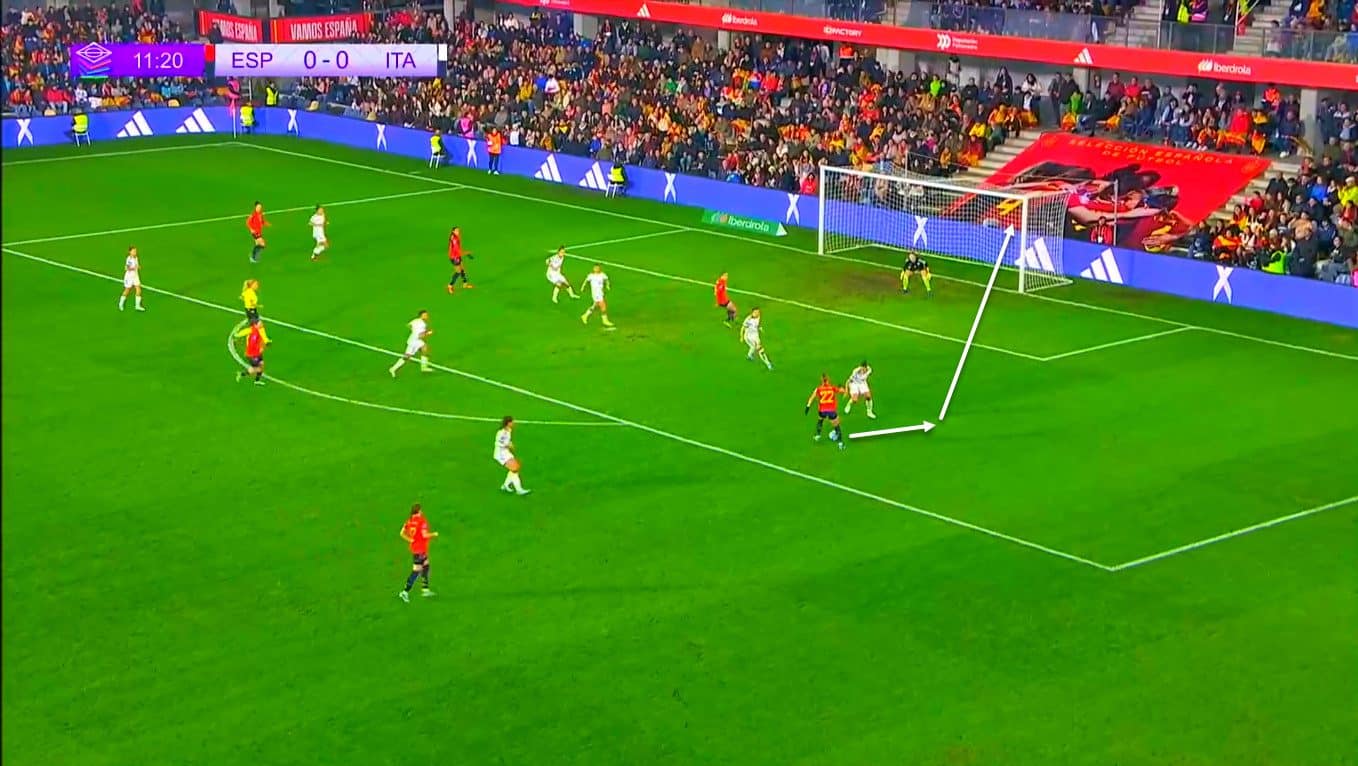
Moreover, Spain are powerful enough in terms of set-pieces and have been scoring a lot of goals from corners lately, as most of their players are good enough in the air.
Spain also know how to exploit spaces left by defenders, as they know how to attack these spaces with key passes and quick movements from midfielders/attacking players.
In this regard, Hermoso represents a “joker-like” player in this team as she is a striker who is employed as a midfielder.
This means that Hermoso plays in midfield and provides key passes but suddenly advances to act like a second striker or a proper striker during some actions.
This goal action highlights her ability to still play as a striker and move extremely well without the ball to meet her teammate’s pass in the space left by the opposing defence.
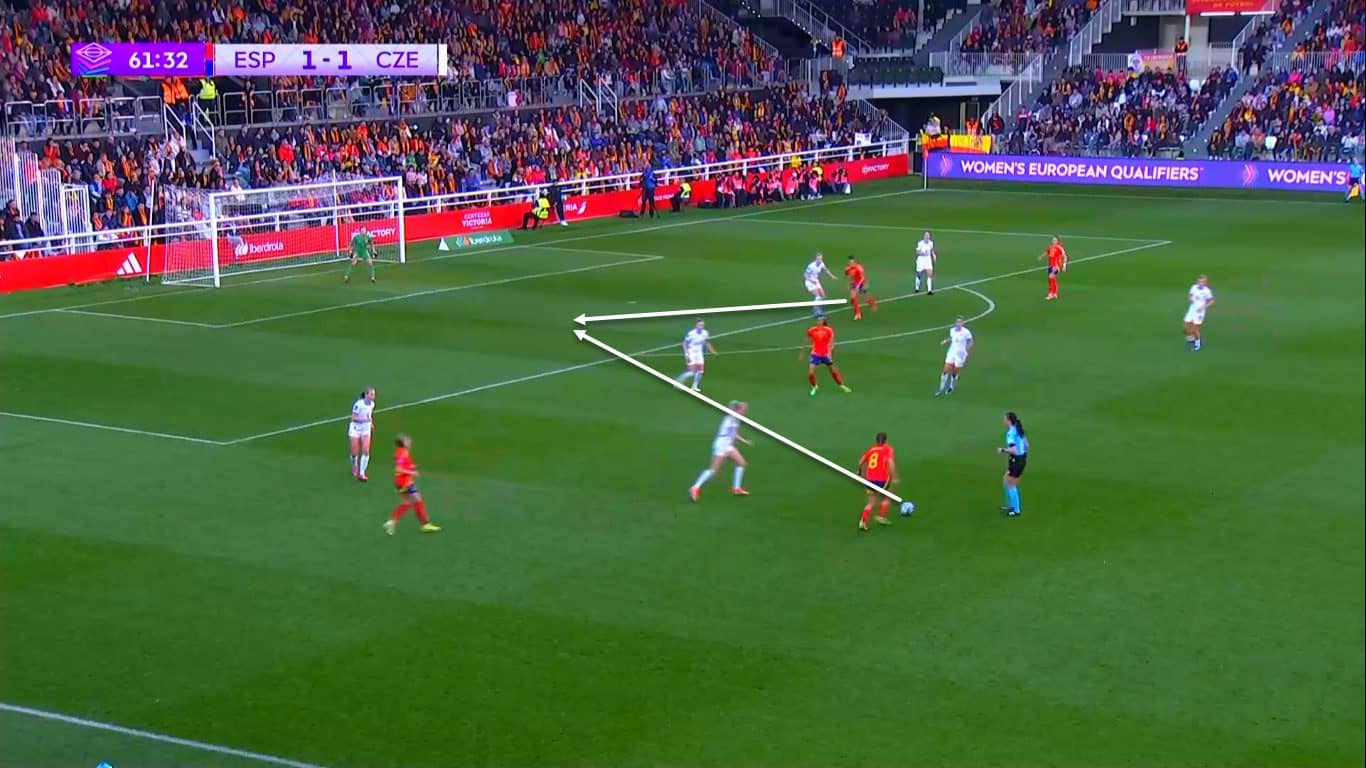
Spain do have a lot of options upfront but must not underestimate their opposing defences and make sure to vary their attacks even further during this tournament as their mission will surely be more complicated as they are actually “the team to beat”.
As World Cup champions, all opponents will be preparing extensively to find ways of stopping Spain’s attacks by studying them thoroughly.
Defensive Phase
Regarding their defensive phase, it is fair to argue that Spain can be considered among the best teams from a defensive perspective, as they have a very compact and disciplined defensive line.
They concede 0.8 goals per game on average and concede about 5.2 goals per match.
With experienced defenders who have been playing together for a while, such as Irene Paredes and Laia Codina, and the support of the two full-backs Ouahabi and Battle, Spain are expected to perform well in defence.
Nevertheless, a lot more work will be needed when facing Brazil, Japan and Nigeria as the three teams are actually having potentially dangerous attacking players such as Asisat Oshoala and Uchenna Kanu for Nigeria, Maika Hamano and Hinata Miyazawa for Japan and Marta, Ludmila, and Jaqueline for Brazil.
Paying extra attention when facing a team like Japan will be essential as Spain have already played against this team recently and precisely during the latest World Cup when Japan succeeded in beating Spain 4-0.
Therefore, Spain’s players surely remember this encounter and will need to know how to approach such a game in order to be able to “take revenge” without falling into the trap of precipitation or excessive aggressivity.
The following conceded goal against Japan exposes Spain’s weaknesses in defence and how they can leave gaps at the back of their defensive line, especially knowing that they often use a high defensive line and engage their defenders in the build-up in an advanced way.
When facing teams with very pacey players such as Japan, Spain will need to be more attentive and avoid keeping a high defensive line to be less exposed to counterattacking risks as such teams rely mainly on counterattacks and know how to exploit them perfectly like they did in this goal action.

The same issue happened multiple times and against different opponents during the last period, and that’s why Tomé will need to address this problem quickly to avoid letting opponents exploit it during the Olympics.
Moreover, planning the full-backs’ attacking movements and finding ways to cover for them when they advance is necessary, as failure to do so automatically leads to leaving a lot of space for opponents.
This example against Switzerland shows how Spain’s issues mostly occur due to their high defensive block but also because their full-backs sometimes fail to retreat in time to mark their opponents, which leads to disasters like it did in this conceded goal action.
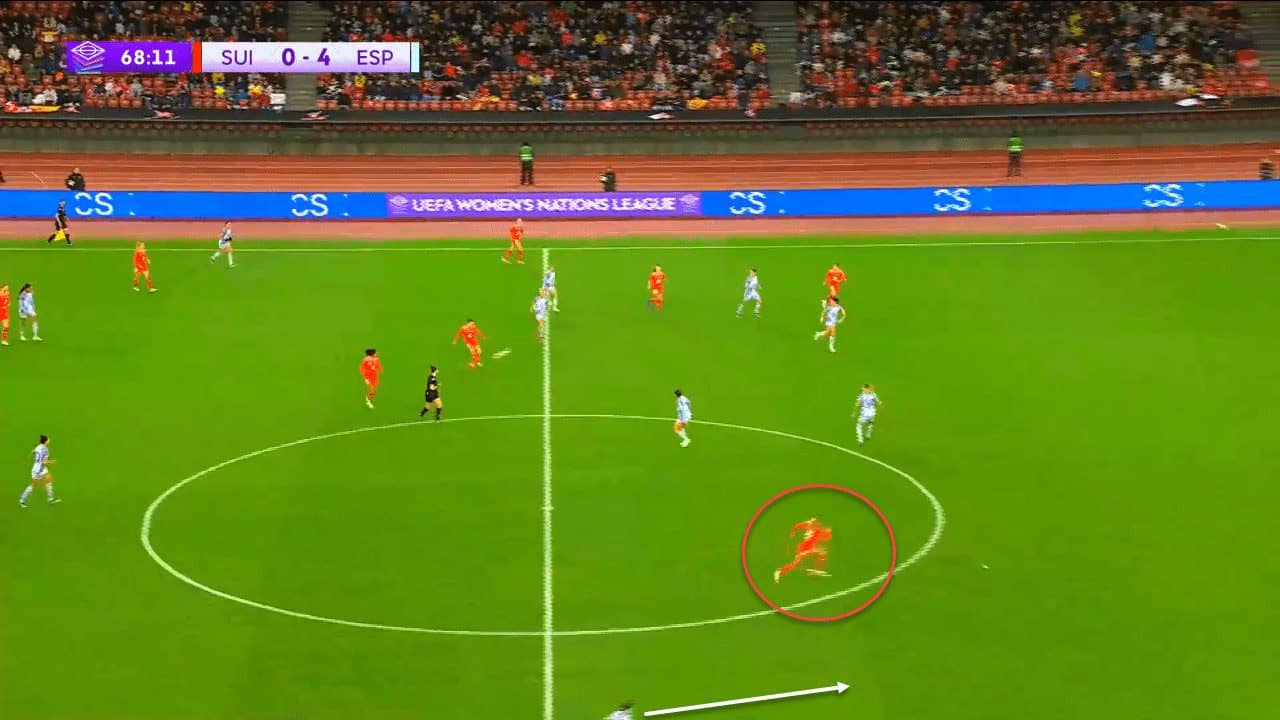
It is true that Spanish players are excellent at passing, can play well under high pressing, and usually do not get affected when opponents disturb them in their own half.
However, avoiding overconfidence will be needed in such a big tournament, as overconfidence might lead to errors in terms of passing or ball protection, for instance.
The goalkeeper, defenders and midfielders will need to avoid complicated passing solutions in defence and try not to overcomplicate things for themselves as the goalkeeper did in this action against Italy when she tried to provide a pass towards a marked centre-back when being under pressure and failed to provide an accurate one instead of opting for a clearance or a pass towards the flanks.
It is true that taking risks is needed in some situations, yet in others, like this one, it is completely unnecessary.
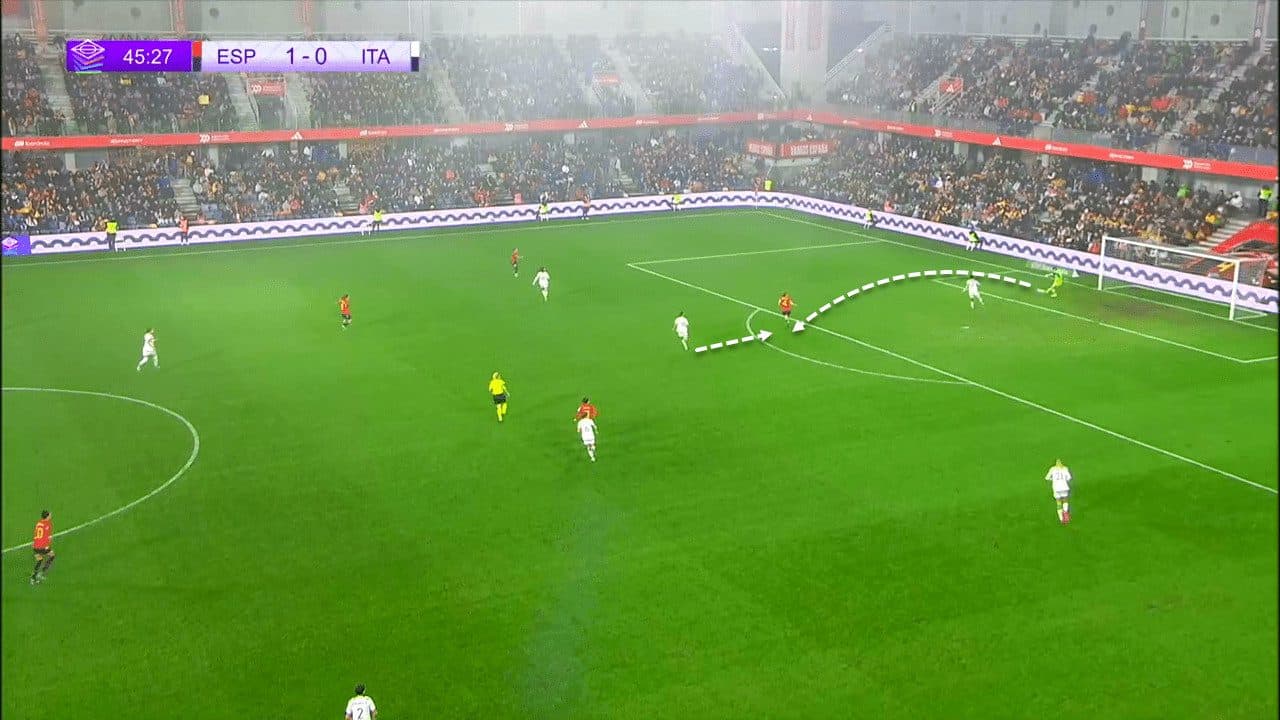
Transitions
For attacking transitions, Spain can be considered one of the best regarding this aspect as they are quick and talented enough to create issues for any defence as soon as they launch counterattacks.
They tend to advance using one of the midfielders, while one or two full-backs advance as high as possible in the opponent’s half.
Afterwards, midfielders either pass to the striker, who drops back to receive the ball or asks for it in space or to wingers, who also free themselves from marking to receive the ball.
Like in the following example, Spain tend to use overlaps of full-backs in a remarkable and extensive way during their attacking transitions in order to find dangerous crossing trajectories inside the box and get rid of marking on the wings.
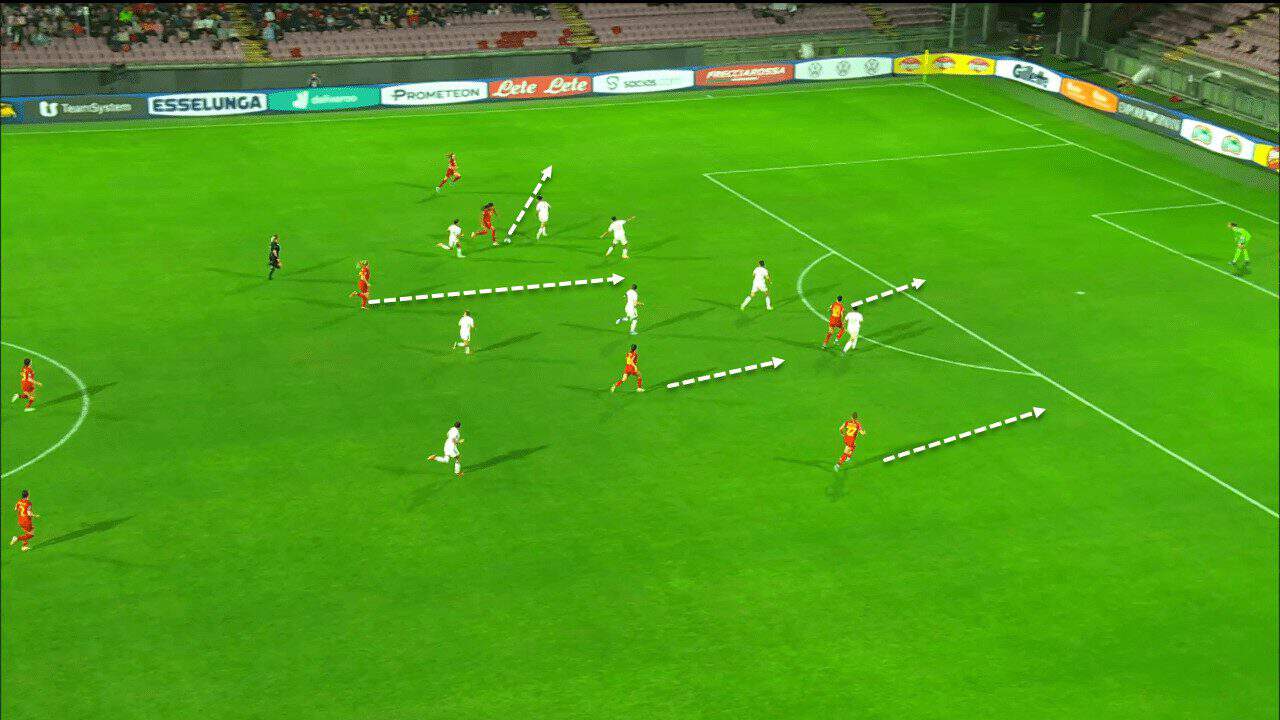
Spain will need to address defensive transitions because failing to do so might lead to serious issues in the long run.
The team often fails to retreat quickly due to the high defensive block and the consequences of attacking with a lot of players.
Spain often find themselves in disadvantageous situations during these actions as they are not able to retreat with numbers instantly due to the mentioned reasons.
That’s why it will be essential to apply tactical changes in this regard to limit conceding disastrous counterattacks.
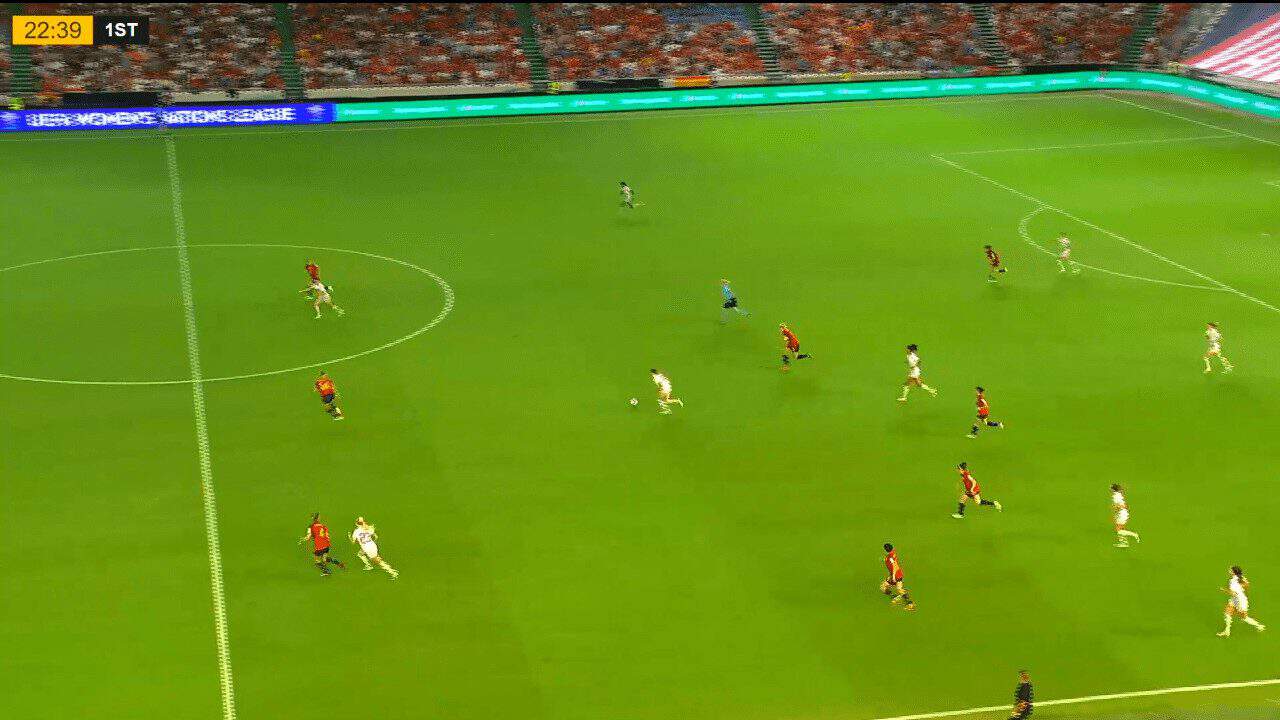
Forwards
Spain has numerous key choices upfront as they are known for having some of the best players in their positions, such as Caldentey, Del Castillo, who is a player to watch during this tournament, and Paralluelo, who is participating to confirm that what happened during the World Cup was not just a coincidence but a glimpse of what Paralluelo is capable of doing for Spain.
The team’s “backup” choices should not be overlooked either, as these names are starters in their respective teams.
The experience and the finishing traits of Esther González will be needed, especially during delicate moments, as she has more experience as a striker than Paralluelo and can replace her effectively whenever needed.
Almost the same applies to Lucía García and Eva Navarro, who are essential for Manchester United and Atlético Madrid and can add a lot to the team’s attack when things don’t go well or when the team needs fresh and dynamic players in second halves.
Midfielders
When it comes to midfielders, it is fair to say that Spain has the best midfield in the tournament.
Two Ballon d’Or winners, Putellas and Bonmatí, are not only complementary but also effective in terms of attacking, playmaking, and defending.
With one of Hermoso or Abelleira (depending on the game and the opponent), Spain guarantees more balance in midfield and adds more attacking additions, especially with Hermoso.
The only thing that Tomé will probably need to work on regarding this midfield is how and when to cover for their teammates in defence and how to be more crucial in the defensive phase to help in conceding fewer goals per game.
Defenders
This area represents the most “problematic” aspect that Tomé needs to improve even though the team have world-class defenders like Paredes and Codina.
However, the defensive tactics need to be altered to take fewer risks in defence and preserve the team’s balance.
Carmona’s injury will not necessarily be an issue for Tomé as Ouahabi can replace her in the best of ways, even though she does not have the same attacking attributes as Carmona.
But in case of other injuries, Spain might be facing serious problems as they are not allowed to have the sufficient number of substitutes to be able to have a replacement for each position.
Therefore, it is expected to see players used out of position in this tournament in case of injuries.
Key Player
The Ballon d’Or and The Best FIFA Women’s Player Award winner, Bonmatí, does not really need a presentation as her records speak for themselves.
She is actually one of the best midfielders in Women’s football, as she has all the traits needed to be a very useful midfielder to any team.
With a passing accuracy rate reaching 88.2% and an ability to win 18.92 duels per game ( 47.6% on average) and 1.45 aerial duels (52.3% on average), she is surely going to help Spain a lot and be their key player, not only during the Olympics but also in the upcoming continental and international tournaments as well since she is 26-years-old at the moment.
The following heatmap shows the areas that Bonmatí covers and how she tends to advance a lot with intelligence while not forgetting her defensive roles.
Bonmatí’s intelligent attacking movements and her ability to always position herself in key areas to propose passing solutions make her more dangerous upfront, as she also knows exactly what to do when she gets the ball in the final third.
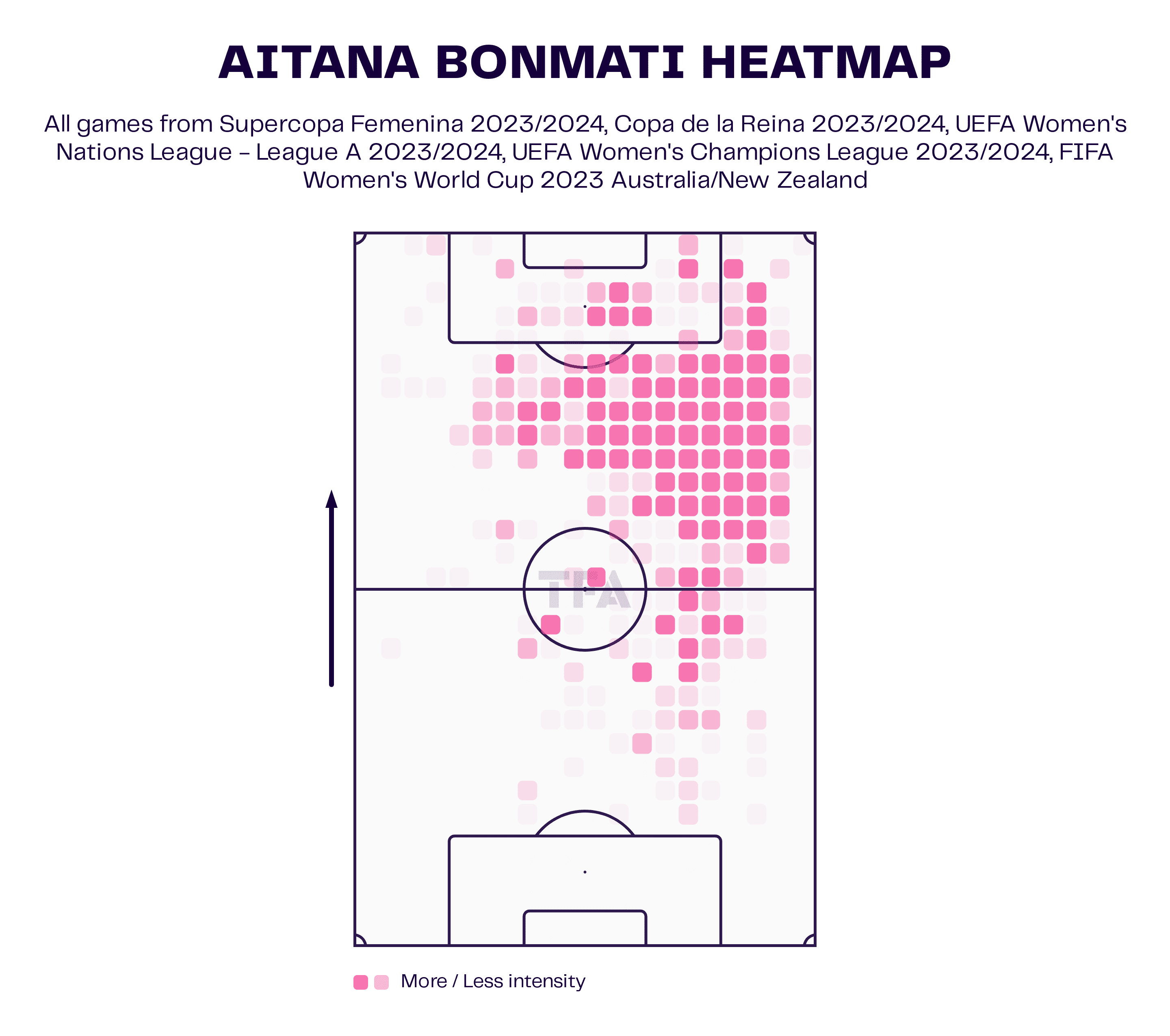
Her quick key passes between the lines usually make the difference for Spain as she also has excellent chemistry with her midfield and attacking teammates, which makes things easier and more natural for everyone.
In terms of goalscoring, Bonmatí scores 0.47 goals per game as she shoots 2.61 times per match.
These numbers do not look bad for a midfielder, especially when knowing that Bonmatí often scores without needing to shoot a lot on goal beforehand.
In other words, one or two shots per match are usually sufficient for Bonmatí to make the difference and score.
Nevertheless, encouraging her to opt for shooting from distance more often might be fruitful in the long run as well.
Tournament Prediction
As World Cup champions, it is obviously expected from Spain to finish at the top of their group and win the golden medal.
However, past experiences have shown that World Cup champions do not necessarily win the tournaments that come just after the World Cup.
That’s why Spain will have to work a lot on the mental level to not fall into the trap of overconfidence and to keep working hard to achieve their target without listening to anyone else’s thoughts on Spain’s chances.
In terms of prediction, Spain will most probably qualify from Group C at the top of their group and will, therefore, be facing the 3rd of Group A or B.
This would give them the advantage to win in the quarter-finals even though the 3rd of Group A or B might be a tough team.
Then, if things go well for Spain and they perform at their best, they can win both in the semi-finals and in the final.

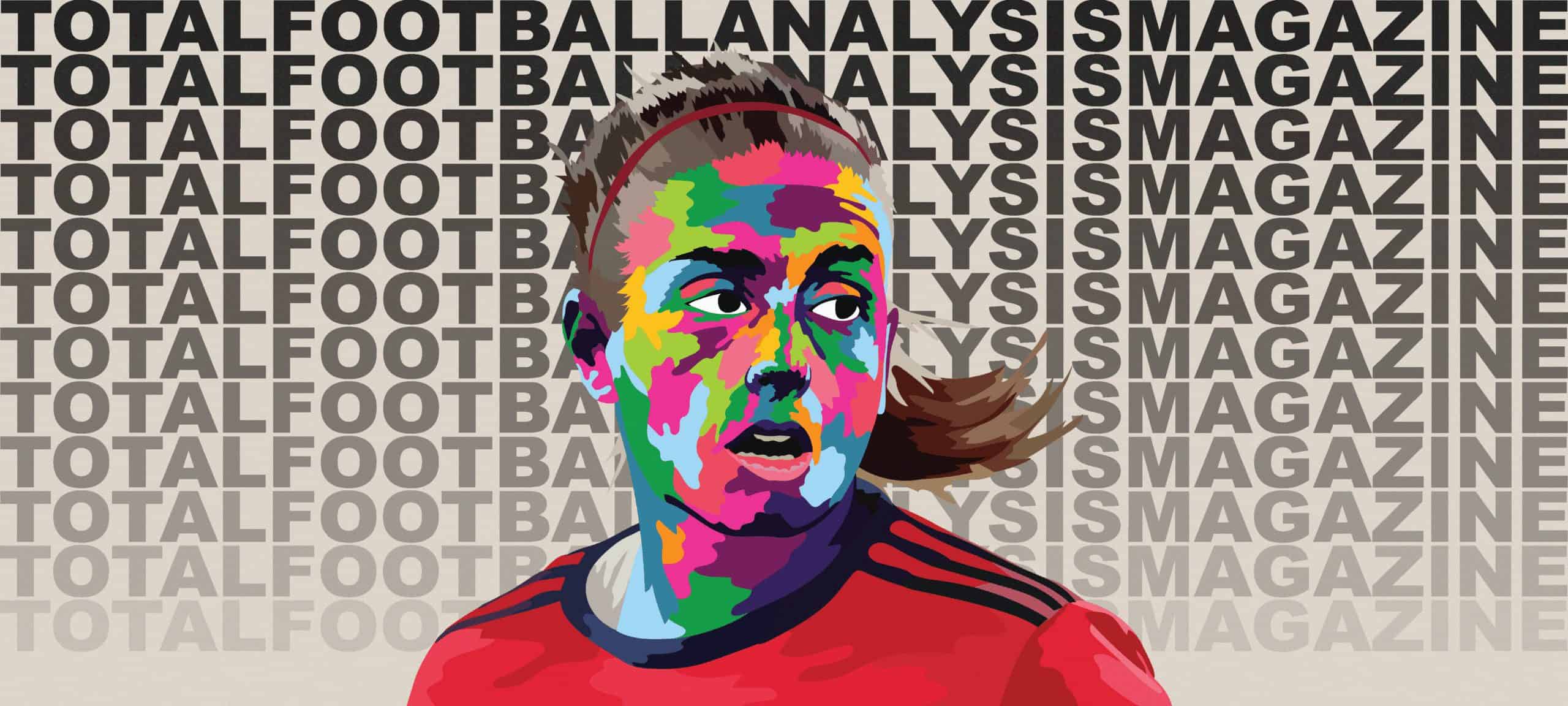


Comments